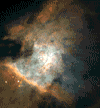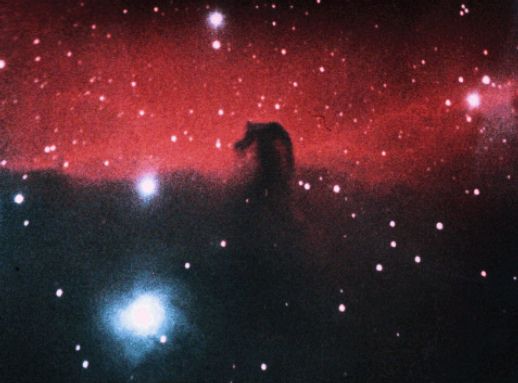This material can be used to fulfill partial requirements for the Astronomer Badge.
Winter Sky Observations:
Orion: The Hunter, has three main stars
that form Orion's belt
 One way the belt points to Pleiades, the other way it point to Sirius
One way the belt points to Pleiades, the other way it point to Sirius
 Rigel: Blue super giant sun, very young - 100,000 years old
Rigel: Blue super giant sun, very young - 100,000 years old
 Betelgeuse: Red super giant sun, very old, 1000 light years away
Betelgeuse: Red super giant sun, very old, 1000 light years away
- This star's radius would reach out to the orbit of Mars in distance
 Has two nebulas (areas of space stars, gas and dust) inside the constellation:
Orion and Horsehead
Has two nebulas (areas of space stars, gas and dust) inside the constellation:
Orion and Horsehead
The Iroquois believe that Orion was a great hunter. The
story goes that he climbed a mountain to prepare for his death. When the end came, he
ascended into the heavens, where remarkably, he recovered his strength. He was
assigned to a new job, to carry the sun high into the sky in the summer. Orion is
indeed located in the Northern day sky during the summer months, its presence blotted out
by glare of the sun. But as winter approached, the hunter grew tired, and passed the
responsibly over to his son. The lazy son shouldered his responsibilities poorly,
and barely managed to bring the sun over the horizon, bringing cold winter days. His
father meanwhile, rests in the winter night sky, gaining strength to resume his role in
the summer.

Pleiades: The Seven Sisters, Les Sept
Soeurs, Oot-kwa-tah (Iroquois)
 Actually only 6 bright stars are visible. Maybe one died out since the constellation
was given a name
Actually only 6 bright stars are visible. Maybe one died out since the constellation
was given a name
 The brightest cluster of stars in the sky
The brightest cluster of stars in the sky
 Also called the Little Little Dipper
Also called the Little Little Dipper
An Iroquois story recounts how a group of eight braves
ignored their chores and instead danced and partied. The Elders warned them that bad
things would happen to them if they continued with the party, but the braves paid no heed
and danced anyway. Soon they grew lightheaded and suddenly began to rise into the
sky. One of the eight braves recognized his father below, and became a shooting star
trying to reach him. That left the seven Pleiades, called Oot-kwa-tah.

Ursa Major: Big Dipper, La Grande Ours
 The two end stars point to Polaris (5 times distance)
The two end stars point to Polaris (5 times distance)
 Shaped like a pot
Shaped like a pot
 In an Ojibway legend, the Big Dipper is a fisher, a member
of the weasel family. One year the story goes, summer did not arrive. A certain
hunter, named Fisher, after the animal spirit that inhabited him, concluded that someone
had captured the migratory birds that brought good weather. The culprit was Fisher's
selfish cousin, Cruel-Face. After a battle, Fisher was able to find and release the birds
of summer. Cruel-Face tracked Fisher down and chased him up a tree, where the hero's
only escape was to follow the advice of the stars and leap into Sky Country. He did,
forming the constellation. But as Fisher leapt, Cruel-Face fired off his last arrow,
wounding Fisher in the tail. To this day Fisher's injured tail - the crooked handle
of the Big dipper - attests to Cruel-Face's desperate shot. And also to this day,
the freed birds bring summer every year.
In an Ojibway legend, the Big Dipper is a fisher, a member
of the weasel family. One year the story goes, summer did not arrive. A certain
hunter, named Fisher, after the animal spirit that inhabited him, concluded that someone
had captured the migratory birds that brought good weather. The culprit was Fisher's
selfish cousin, Cruel-Face. After a battle, Fisher was able to find and release the birds
of summer. Cruel-Face tracked Fisher down and chased him up a tree, where the hero's
only escape was to follow the advice of the stars and leap into Sky Country. He did,
forming the constellation. But as Fisher leapt, Cruel-Face fired off his last arrow,
wounding Fisher in the tail. To this day Fisher's injured tail - the crooked handle
of the Big dipper - attests to Cruel-Face's desperate shot. And also to this day,
the freed birds bring summer every year.

Ursa Minor: Little Dipper, La Petite Ours
 Shaped like a little pot pouring into the Big Dipper
Shaped like a little pot pouring into the Big Dipper
 End star in the handle is Polaris
End star in the handle is Polaris
 Polaris: The North Star, Etoile Polaire, Ke-wa-den-ah-mung (Iroquois)
points to the North Pole
Polaris: The North Star, Etoile Polaire, Ke-wa-den-ah-mung (Iroquois)
points to the North Pole
The Ojibway believe that two male cousins originated the
North Star. The two cousins were good friends as well as great hunters. One
day their grandmother introduced them to two young women who were to be their wives.
But the cousins were suspicious, as they thought that the wives might ruin their
friendship. Sure enough one cousin fell in love with one of the women, and
neglected his friend, who remained a better hunter as he was not distracted. The
hunter left his friend and ascended into the stars to become the North Star,
Ke-wa-den-ah-mung. His cousin who still remained on Earth with his wife cried in the
forest for his lost friendship. His cries started to rebound and resonate over the
hills He became known as Bah-swa-way, or Echo

Cassiopeia:
 Makes a "W" shape in the sky
Makes a "W" shape in the sky
 One star is very near in size to our sun
One star is very near in size to our sun

Milky Way:
 The concentration of stars forming the middle part of our galaxy
The concentration of stars forming the middle part of our galaxy
The Ojibway call the Milky Way the Path of Souls. As
part of their burial ritual, a campfire was lit near the post marking the grave. The
fire was kept burning for four days to light the way for the soul-spirit, who must travel
the Path of Souls to reach the Land of Souls.

Sirius:
 The brightest star in the sky and the third closest star to us - 9 light
years away
The brightest star in the sky and the third closest star to us - 9 light
years away
 Also called the Dog Star and was a very important star to ancient Egypt
Also called the Dog Star and was a very important star to ancient Egypt
 Has a dwarf companion star called the Pup
Has a dwarf companion star called the Pup
 It would take 300,000 years to get to Sirius with our fastest spaceship
It would take 300,000 years to get to Sirius with our fastest spaceship
 Sirius helped the Egyptians determine that the year is made up of 365 days (the system we
use today)
Sirius helped the Egyptians determine that the year is made up of 365 days (the system we
use today)

Andromeda Galaxy:
 The nearest galaxy to us, 2,000,000 light years away
The nearest galaxy to us, 2,000,000 light years away
 Like our Milky Way in shape
Like our Milky Way in shape
 The furthest visible object you can see without a telescope
The furthest visible object you can see without a telescope
 The even wedge of Cassiopeia points to the Galaxy
The even wedge of Cassiopeia points to the Galaxy
Scientists looking at data from the Hubble telescope
estimate that there are 145 billion galaxies in the universe. As each galaxy
contains trillions of stars, chances are we are not alone


 Andromeda Galaxy/Orion Nebula/Horsehead Nebula
Andromeda Galaxy/Orion Nebula/Horsehead Nebula
Exercise: Using Star Chart
2, have the Cubs try to find the Constellations and Stars found in Star Chart 1. Then show
them the answers. The description and pictures above might help. Then take the Cubs
outside to see the real thing.